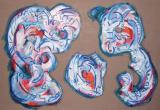THE CHOCOLATE FACTORY CONTINUES ITS 4th PRESENTING SEASON
5-49 49th Avenue, Long Island City, NYC 11101
7 train to Vernon/Jackson (1st stop in Queens - 5 minutes from Grand Central!)
Judy Rifka / Nostos / New Collages and Paintings
September 13 - October 20, 2007
Opening Reception - Saturday September 15, 5-7pm
Chocolate Factory Gallery Hours:
Thursdays and Friday 5-8pm, Saturdays 3-8pm and by appointment.
www.chocolatefactorytheater.org for show schedule and detailed directions.
718/482-7069
Press contact: Patrick Neal 718/482-7069
patrick@chocolatefactorytheater.org
http://www.chocolatefactorytheater.org/e_judyrifka.html
 Marjoke and egon: Oil on Linen on Linen Field, 54" x 80"“Good hands.” In painting parlance, the term connotes not just skill, but a quality of touch that eludes almost everyone, including artists. Rifka, adept at riveting movement on the canvas, is equally plastic with her use of materials; neon-intense colors suggest contemporary “internet safe” hues, and digital video; 360˚ stretchers defy method. Rifka's nervous line, always transgressive, sketches the flowering of the grotesque. Fleshy petals, bone, and teeth. One often encounters contemporary arguments that dissect the corpse of culture, but Rifka's task is to classify the extraordinary appeal of the teratoma. Graceful paisleys of genetic manipulations / biological technology / human-machine crossbreeds.
Marjoke and egon: Oil on Linen on Linen Field, 54" x 80"“Good hands.” In painting parlance, the term connotes not just skill, but a quality of touch that eludes almost everyone, including artists. Rifka, adept at riveting movement on the canvas, is equally plastic with her use of materials; neon-intense colors suggest contemporary “internet safe” hues, and digital video; 360˚ stretchers defy method. Rifka's nervous line, always transgressive, sketches the flowering of the grotesque. Fleshy petals, bone, and teeth. One often encounters contemporary arguments that dissect the corpse of culture, but Rifka's task is to classify the extraordinary appeal of the teratoma. Graceful paisleys of genetic manipulations / biological technology / human-machine crossbreeds.
Judy Rifka: seminal to the development of a downtown scene that
fostered such artists as Keith Harring, David Wojnarowicz and Bruce Nauman-and the use of multi-dimensional canvases, video, and a meld of pop, abstractions and figuration. Her pop figuration is noted for its frenetic pace. Joseph Masheck details Rifka's energy in his 1993 book, Modernities: “Rifka's wit, which luckily keeps up with her anxious agitation, entails putting high care into a 'careless' look. And in a world charged with contending impersonal forces, this is like advertising in reverse, 'pushing' the individual consciousness in all its brave fragility.” In the January 1998 issue of Art in America, Vincent Carducci echoed Masheck, “Rifka reworks the neo-classical and the pop, setting all sources in quotation for today's art-world cognoscenti.”
Rifka was among the pioneers of breaking down the distinction between abstraction and figuration: a distinction very real in the mid 80s. Pop Art, at that time, was also looked on as its own category; Rifka, along with artists like David Wojnarowicz, helped to take the Pop sensibility into a milieu that incorporated politics and high art into Postmodernism. Robert Pincus-Witten makes the point in his 1988 catalogue essay, "Corinthian Crackerjacks & Passing Go": “Rifka's commitment to process and discovery, doctrine with Abstract Expressionist practice, is of paramount concern though there is nothing dogmatic or pious about Rifka's use of method. Playful rapidity and delight in discovery is everywhere evident in her painting.”
Rifka's career spans over 50 one-person shows; work can be viewed in museums and foundations throughout the United Stated and Europe. She has been featured in major exhibitions at the Downtown Show, Gray Art Gallery, NYU; 1983 Whitney Biennial; 1975 Whitney Biennial; Museum of Modern Art; Documenta VII; San Francisco Museum of Modern Art; Carnegie Mellon University; Institute of Contemporary Art, Philadelphia; New Museum of Contemporary Art; Brooklyn Museum; New York Public Library; Kunsthalle, Banne; ICA, London; Aldrich Museum of Contemporary Art Museum; Laforet Museum, Tokyo; Kansas City Art Institute; Mint Museum, Charlotte; Bass Museum of Art, Miami; Museum of Fine Art, Boston; Rhode Island School of Design.
Founded in 2003, The Chocolate Factory is a 5,000 square foot multi arts facility that supports three distinct performance programs: [1] the creation of new work by Artistic Director Brian Rogers and his collaborators; [2] a curated Visiting Artist Program of dance, theater, music and multimedia performances; and [3] an ongoing series of exhibitions in our storefront gallery space.